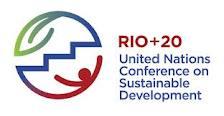Dr Chukwumerije Okereke, Reader in Environment and Development and Director of Research in African Environment and Development in the School of Human and Environmental Sciences, writes about the forthcoming Earth Summit and why justice must not be overlooked.
Between June 20 and 22 many world leaders, civil society groups and a bevy of media organisations will gather in Brazil to commemorate the 20th anniversary of the United Nations Conference on the Environment and Development (Earth’s Summit) held in Rio de Janeiro, Brazil, 3-14 June, 1992. The Rio Summit remains the largest ever global conference on environment and development convened by the United Nations.
 The stated objective of Rio+20 is to secure renewed political commitment for sustainable development and assess the progress to date and the remaining gaps in the implementation of the outcomes of the major summits on sustainable development. The two themes for the conference are: (a) a green economy in the context of sustainable development and poverty eradication; and (b) the institutional framework for sustainable development.
The stated objective of Rio+20 is to secure renewed political commitment for sustainable development and assess the progress to date and the remaining gaps in the implementation of the outcomes of the major summits on sustainable development. The two themes for the conference are: (a) a green economy in the context of sustainable development and poverty eradication; and (b) the institutional framework for sustainable development.
There is no doubt that the 1992 Earth Summit was a critical landmark in the history of global environmental governance. It continues to: (i) serve as an inspiration for humane international co-operation and multilateral environmental diplomacy; (ii) provide impetus for the quest for an ecologically secure and sustainable planet; and (iii) remind everyone of the need for a truly democratic platform for bringing together governments and civil society in the search for solutions to challenges that threaten humans’ common existence.
Rio 1992 produced three main agreements, including the UN Climate Change Convention, the Convention on Biodiversity and the Forest Principles. However, important as these three treaties are, it is probably fair to suggest that the most important outcome of Rio 1992 was the institutionalisation of the concept of sustainable development – the recognition that environmental protection and human welfare are inseparable parts of the development process and cannot be considered in isolation. Despite, however, many conventions and treaties related to sustainable development since 1992, the levels of global poverty and environmental degradation both remain unacceptably high.
It is right then that Rio+20 should focus on assessing the progress that has been made to date and the barriers standing against the achievement of global sustainable development. As an ethical concept, the intuitive appeal of sustainable development resides in the attention it gives to three key dimensions of justice: (a) justice within and between nations; (b) justice between present and future generations; and (c) justice between human and non-human nature.
Today, distributional justice remains central to any effort to achieving sustainable development as it did 20 years ago. And only careful attention to the three dimensions of justice above can ensure the achievement of a lasting balance between economic, environmental and social dimensions of development which the concept of sustainable development envisages. In fact, I am convinced that the current lack of attention to justice is the most important barrier against the design of effective policies and institutions for achieving national and global sustainable development. In other words, Gro Harlem Bruntland was right when, in 1987, she declared that: “It is futile to attempt to deal with environmental problems without a broader perspective that encompasses the factors underlying world poverty and international inequality.”
Green Economy has emerged as the new buzzword in preparation for Rio +20. However it must be noted that emphasis on ‘green economy’ does nothing to affect the centrality of distributional justice in the quest for sustainability. There will certainly be winners and losers in the transition to a global greener economy, at least in the short term. Moreover, the move to a green economy would itself entail material costs, and green products and services may generate their own externalities and risks. States, businesses and the civil society gathering in Rio in June must therefore ask how policies and institutions aimed at encouraging a greener economy can better take account of the full range of justice impacts and prospects such a transition would generate. In discussing this matter I suggest that lasting answers can only be achieved in Rio if the following four perspectives are adopted:
- Distributional justice should not be seen as merely instrumental but at the heart of sustainable development
- Questions of environmental justice must be seen as questions about the mode of wealth creation and appropriation itself rather than as an add-on optional extra. Hence, achieving global sustainable development should be seen to require more radical interrogations of the basic structure of the international society and of patterns of social relations between the poor and rich
- The idea of global environmental/planetary citizenship should not been seen as mere moral lectures but one that deserves to be taken as the foundation upon which institutions for environmental governance should be built
- The current global economic recession should be seen as an opportunity (not as a hindrance) to tackling unsustainable development and world poverty.
To stand any chance of meeting the aspirations of the majority of the global population that has been clamouring for global sustainable development, international management approaches must strive harder to reflect responsible stewardship and the fact of our common inheritance of the planetary resources. In short for Rio to succeed, the idea of justice must be reinstated at the centre in the quest for new green global economy



